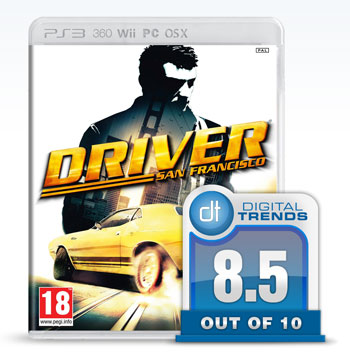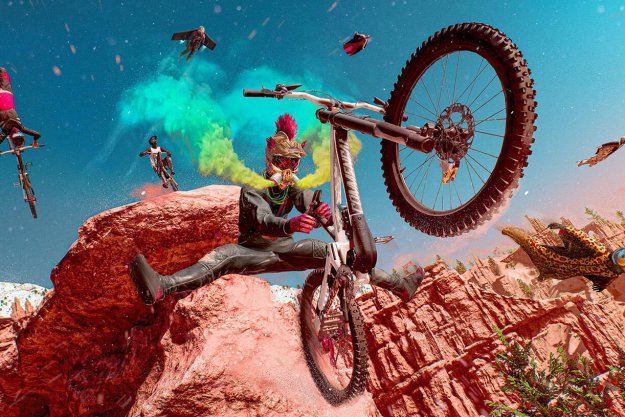 If you are a gearhead, Driver: San Francisco may not be for you. If you look forward to tuning the suspension in a game, then you may want to look elsewhere. Driver: San Francisco is about as far from being a technical racer in the vein of Gran Turismo 5, as any racing game can be. It is an arcade-style driving game, with an insane and slightly crazy premise, that offers one of the best new twists on the genre in years.
If you are a gearhead, Driver: San Francisco may not be for you. If you look forward to tuning the suspension in a game, then you may want to look elsewhere. Driver: San Francisco is about as far from being a technical racer in the vein of Gran Turismo 5, as any racing game can be. It is an arcade-style driving game, with an insane and slightly crazy premise, that offers one of the best new twists on the genre in years.
The game also has its own sense of cool. It harkens back to the detective dramas of years past set in San Francisco, like Bullit and Streets of San Francisco, where the ominous “wa-chicka-wa” music proceeded the musical horns to signify that something exciting was about to happen. The game feeds on that nostalgia for those that remember it, and for those that don’t, it creates a unique tone that doesn’t take itself too seriously.
Simply put, Driver: San Francisco is just flat out fun. It has a few issues, but fans that like racing but are tired of having to buy new tires and windshield wipers and the like, may find the title they have been waiting for. Plus, fans of the Driver series might not like that the game has steered away from its dark and gritty premise towards a more fun-action theme that is accessible to all, but they will probably be glad to know that one staple of the original games remains—the insanely hard mission.
Welcome to Tanner Frisco
The premise of Driver: San Francisco is a bit odd, but it is essential to creating the mechanic that makes this game so much fun: the shift mechanism. The game begins with series protagonist Tanner escorting his arch-enemy Jericho to the courthouse for sentencing. Inevitably, as you might expect in both a video game and a 70s themed detective drama, Jericho escapes. Tanner isn’t about to let him go, and the resulting car chase ends up with Tanner in a coma. An awesome, awesome coma.
Tanner is unaware of his state, and thinks that the accident was just a brief bump on the head. Everything is just like it was before, except that he discovers that he has a new ability—the shift mechanism. The shift allows Tanner/you to pick his consciousness up and deposit it into the driver of (almost) any car in the city. He simply takes over the body of the driver, which leads to some confusing, and occasionally hilarious moments, especially when there are passengers in the car that have no idea why their driver suddenly decided to jump their car over a freeway.

As Tanner learns to control the shift mechanism, he then becomes a guardian angel of sorts to San Francisco, and can jump into dozens of side missions to help the people, or he can ignore those side quests entirely and stick to the primary plot where he thinks he is hunting down Jericho.
The primary plot is actually fairly interesting, and the variety of missions make the way the story unfolds compelling. If you skip all the side quests, then you can make it through the game in under 10 hours. If you take your time and try the side quests, then you can add at least five hours, even though they eventually become repetitive.
Shift Happens
The shift mechanism is really what sets this game apart. It is more than just a gimmick, it really is a different way to play a game like this. At any time (as long as the mission doesn’t specifically prohibit it), you can jump out of one car and into another. The mission types vary, so in one instance you may be chasing a perp in a traditional “wreck them” chase. But instead of just catching them and putting them in a wall, you can shift into a semi and hit them head on, or maybe shift into a bus and block the road. If you want to get creative, you can even shift into a truck with a ramp on the back (of which, there are apparently hundreds in San Francisco), then slam on the breaks to make the perp fly into a building. The options are many, and the more you get used to it, the more creative you will become.
There are plenty of moments of humor too as you shift into unsuspecting people and their passengers are suddenly in a car going 100 mph down the Embarcadero. The shift mechanism essentially does away with the standard pursuit model of racer—unless you don’t want it to. It is easy to become overly reliant on it, but that isn’t the game’s fault. On some missions you need to use shift, but not all. It just opens the game up and makes what could be average and predictable missions into something fresh and unique.

The car controls are a bit simplistic, but the physics are consistent. They are designed as an arcade racer, so there is a lot of leeway when it comes to the play controls. Each car handles a bit differently—as they should—but the physics are obviously designed with the sense of fun far outweighing the actual representations of a car’s real life counterpart.
For those that have played the simulation racing games, the controls might be overly simplistic, but for the people that find those sims overwhelming, or just don’t like the stiffness inherent in a real life car, then the D:SF controls are right where they should be.
Spoiler: The Online is Fun
When it comes to racing games online, they are either simplistic (i.e. standard races), or they are designed for the hardcore fan that wants to interactively redesign their car in a virtual racing world. D:SF manages to take the core mechanics and make the online fun. It may not have the lasting appeal that other online games have, but it is more than just an amusement.
The game modes vary, and there are both co-op and competitive options. Standard races are included (with shift deactivated), but there are a few unique game modes. With co-op, you can work with a friend to take out targets or escape pursuers, or you can go competitive in games like tag, where one car is it, and the others try to catch or shift into a nearby car to hit/tag them and become it. There is also a trailblazer mode where you need to stay in the leader’s wake to score points, and several others.
Altogether there are nine online modes, and there are experience points to be earned throughout to level up. It probably won’t be the “next big thing” online, but the D:SF multiplayer is a great diversion, and just adds value to the already robust single player. The co-op matches will probably attract friends, but the tag game is incredibly addictive.
The Randomizer Hates You
While there are a lot of differences between the older Driver games and D:SF, there is one legacy that occasionally rears its ugly head: the game can be freaking hard.
If anyone remembers the very first Driver, and they had the fortitude/stubbornness to beat it, then they remember “President’s Run.” It was sick. Developed by people that still yearned for the days of the NES, where developers were mad at you if you actually beat their game. In the mission, you kidnap the President for his own good, then proceed to try to survive wave after wave of Secret Service and Police assault who were apparently ok with a “if we can’t have him, no one can” mentality when it came to the President.

God help you if you needed to blink. It was frustrating and insanely difficult, and required as much luck as skill. That cheery feature returns, to a smaller degree. Sometimes the game–especially later on in missions where there is a time limit of any kind–could make the Dali Lama want to punch a Care Bear in rage. It comes down to luck more often than not. Sometimes the corner before the finish is clear, other times there will be a bus. It is random, and unforgiving.
This is especially true later in the game, but you see it throughout. It gives the missions all a unique feel when you repeat them over and over, but it is annoying too. I personally lucked through several missions, as much by accident as anything, but the potential for rage quits can be high. In one instance I re-played a race for a solid 45 minutes, then right at the finish line, my opponent hit a truck and I won, purely by luck. I took it and graciously moved on. These missions come and go quickly, and they may affect some more than others.
Conclusion
Driver: San Francisco is a ton of fun to play. It’s addictive, the arcade-style controls work perfectly with the mentality of the game, and the graphics border on amazing—especially the facial animations, which blew me away. The missions also have a lot of variety, and the city of San Francisco is teeming with events and side missions. Toss in a respectable online mode, and there is plenty to like.
It isn’t all roses though. While the facial animations are great, the body movements are blocky and odd. The cut scenes are also great until there is action, then it looks dated. For those that just play the campaign and no side missions or online games, then D:SF will be a short and slightly unremarkable. Throw in the occasional insanely difficult level of difficulty, and they could flat out hate it.
Overall there is far more to like in Driver: San Francisco than dislike. It fills a gap for driving fans that are looking for mindless action rather than technical sophistication, and in that it is a total success.
Score 8.5 out of 10
(This game was reviewed on the PlayStation 3 on a copy provided by Ubisoft)
Editors' Recommendations
- Epic Game Store fights back against review bombs with new user rating system
- Grand Theft Auto: San Andreas is leaving Xbox Game Pass
- The best racing games on PlayStation 5
- How to earn more Republic Bucks and Coins in Riders Republic
- What are Sponsors in Riders Republic?


